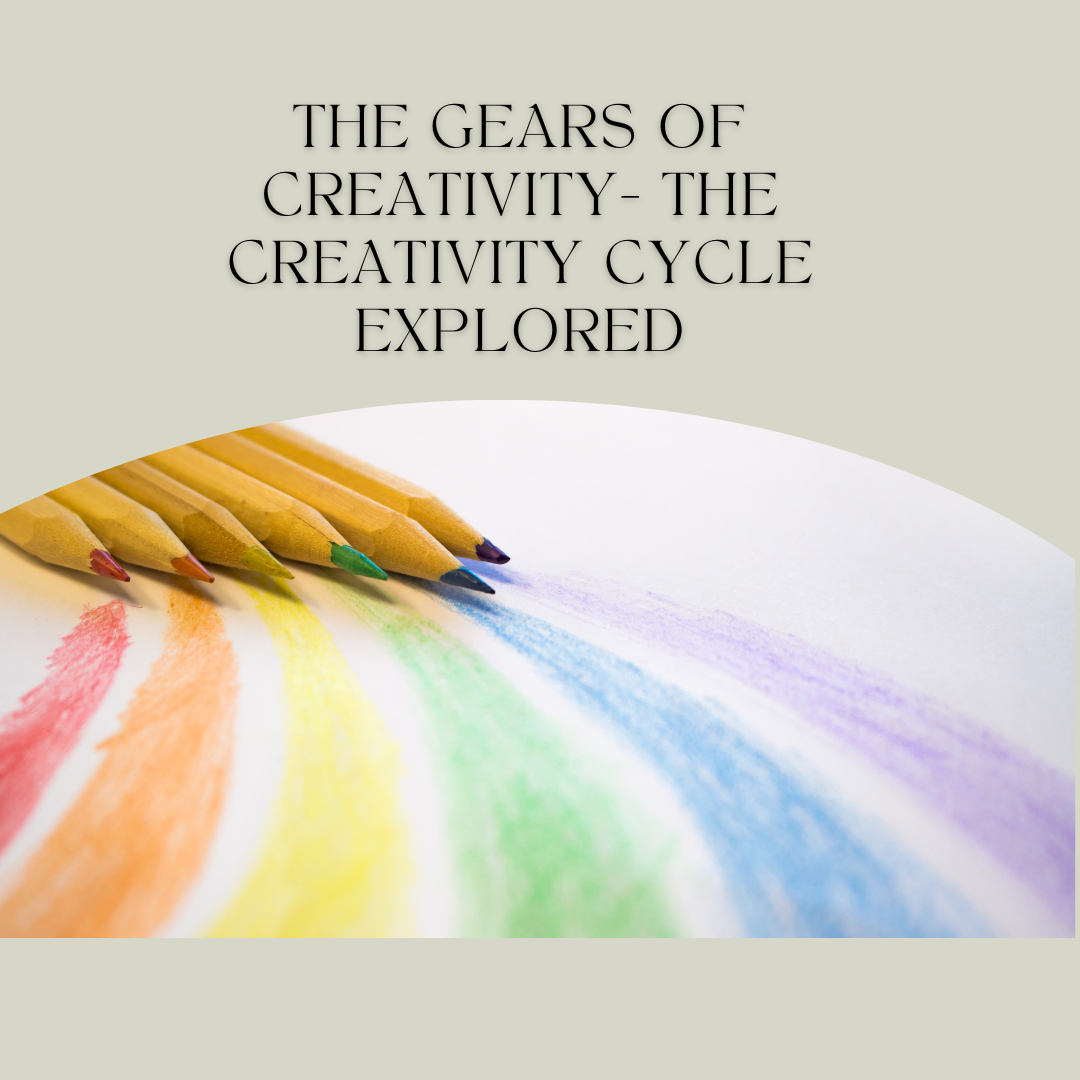Welcome to the heartbeat of Integrative Counsel, our blog where tranquility meets transformation. This is your sanctuary for insights and wisdom on nurturing a harmonious connection between mind, body, and spirit.
The Gears of Creativity-The Creative Cycle Explored

In my previous article, Why the Creativity Cycle is Like an Outstanding Cup of Coffee, I discussed the necessary ingredients of the creative process, such as the importance of protected time, a culture that supports creativity, constraint within the creative process, and not taking the process too personally.
In this article, I’ll explore the creative cycle and its relationship to our current understanding of the brain. The importance of dissecting the creative process and organizing it into a guiding metaphor is manifold.
As anyone who has tried to bring a creative impulse from ideation to iteration can attest, there is a great risk of getting lost in the creative process. Understanding the cyclical nature of the process can offer perspective and clarity. It can also supply “gas” for the long haul, giving fledgling ideas the chance to come to fruition.
Different skill sets are needed in each stage of the creative cycle.
If you know where you are, you can seek assistance to close any gaps in your knowledge. You can also take the necessary measures to protect your time and resources in each phase of the process — even those in which it appears as if not much is happening.
There are a number of diagrams and stage theories that outline various steps within the creative cycle. For our purposes here, each step will be represented by a gear, in order to emphasize that the process is not a linear, but rather cyclical and interconnected. I’ll also describe each step in relation to the structure and division of the brain. (For more on this, see my previous article on imagination).
The brain can be divided in multiple ways. However, an important distinction to look at in terms of creativity is how the brain is divided horizontally.
There are two hemispheres: the left and the right. Though the hemispheres work in concert to create a unified sense of self and personality, each hemisphere attends to the world differently and, therefore, processes information in distinct ways. This provides us with great advantages, including the ability to understand a situation from many different perspectives, as each gear in the cycle of creativity allows for various vantage points. We’ll explore each of these gears in detail below.
Gear 1: Preparation
Preparation is a fundamental part of the creative cycle. Although it’s not the “sexiest” part of creativity, this is the stage in which you are doing your homework and setting the stage, defining the constraints and framework (link to the previous article), for your project. Here, you are elbow deep in research and working primarily from your left brain. The left hemisphere is the great “unpacker” of information; it breaks information down by sorting, categorizing and analyzing.
Gear 2: Incubation & Insight
While the left hemisphere specializes in language, logic, and facts — which are imperative during the preparation phase — the incubation and insight stage requires a letting go of linear and conscious thought processes. Insights, or “a-ha moments”, happen when we are not concentrating specifically on the project. In these moments the right hemisphere is activated, and you need to allow time and space for your ideas to percolate. This is how you allow the web of interconnected ideas — however incongruent they might seem — to surface as a cohesive insight.
You might be asking yourself, “How do I stop consciously thinking and allow this process to develop when I have a deadline to meet?” It’s a common question. For those who consider themselves creatives, this might be a no-(left)brainer (pun intended). However, for those who are used to thinking in a strictly analytical fashion, it will feel very, very different.
The right hemisphere doesn’t use everyday language (which is housed in the left hemisphere) to communicate. It usually communicates without words; for example, you’ll get a gut feeling, or an image or diagram will pop into your head seemingly out of nowhere. So we have to learn to listen in different ways. A few ways to begin to listen differently include:
- Find ways to transcend language, such as with the use of imagery
- Creativity (crafting, cooking, gardening, etc.)
- Spending time in nature
- Stepping back to see the whole picture (what I call “zooming out”)
- Being embodied (practicing yoga, dancing, etc.)
- Listening to music
- Welcoming opposites. The tension of opposites is part of the creative process and can produce results that are greater than the original parts. (Brain science tidbit: The right hemisphere has the ability to hold dichotomy. It does not categorize things as opposites, but rather sees them as connected and in relation to one another.)
These are just a few ways you can practice tuning into your brain’s right hemisphere. As you learn to listen differently, keep in mind that bringing this information into our daily lives does take a certain amount of trust.
Gear 3: Evaluation
Here you have a chance to turn your idea back over to the left brain and sort out the logistics. Now is when you ask yourself if your project is worth taking all the way to iteration?
David Kelley, founder of the Stanford d.school, and his brother, Tom Kelley, are New York Times bestselling authors of the book Creative Confidence: Unleashing the Creative Potential Within Us All (Crown Business, 2013). They have a set of guiding principles that can aid in this evaluation: FIRST, with genuine curiosity, ask “What is desirable (human)?” THEN, ask, “What is viable (business) and feasible (technology)?”
Gear 4: Integration, Imagination & Iteration
Imagination is based on the creative power of opposition, and is a result of the synthesis between the right and left hemispheres. Imagination, insight, and creativity all require this integration of the left and right hemispheres.
This stage requires you to get your hands dirty and do it! It is where head and heart, brain and body, and conscious and unconscious come together to manifest your masterpiece — or complete failure!
Remember that failure is an inevitable part of the creative process. It doesn’t mean your idea or product is necessarily bad. It just means you have the opportunity to go through the creativity cycle again, with your newfound knowledge, so you can make it even better.
It is also important to remember — especially in this part of the cycle — that fear in its many manifestations will arise. It presents itself in every stage, but as you prepare to actually create, it can become even more pronounced. Fear lets you know you are on the edge of your comfort zone, and you are about to grow. This is a good thing. So don’t run away from your fear; run towards it. (Stay tuned for my next article, which outlines how you can embrace fear through mindfulness techniques).
Gear 5: Upleveling
Gear 5 connects back to Gear 1. The left hemisphere, dissecting information in a highly focused and narrow way, offers many contributions, including breaking down tasks and learning complex sequences. However, it is essential to return this information to the right hemisphere, where it can again be viewed within the context of the whole. This is where perspective comes from, as well as the ability to attend to new information in our environments. In this phase, we start the creativity cycle anew, but upleveled: armed with our newfound learning, product, and understanding.
It is my sincere hope that this, admittedly, very left-brain dissection of the creative process will help you manifest your next creative idea. It just might be an idea that can help change the world for the better.
Sign up to receive our virtual magazine in your inbox! We send free resources, art and journal prompts, wisdom from our practitioners, and more. Click here to get on the mailing list.
Dayna Wood is the founder of Integrative Counsel; at Integrative Counsel, we offer an eclectic style of treatment that integrates the mind, body, and transpersonal. Our “special sauce” combines creative, out-of-the-box thinking with solid scientific research so our clients get the best of both worlds. Our team of experienced counselors has specialized knowledge in relationships, trauma, OCD, and other expansive therapies – aiding people in uncovering deep-rooted emotions and beliefs that remain the cause of present-day symptoms so they can experience more persistent breakthroughs. We understand that mental health is more than just its symptoms!
November 7, 2023
Click here to book a consultation call and start navigating your personal path to mental harmony with a therapist who gets you. Your journey, your pace, your story—let's unfold it together.
Let's keep the conversation going.
Feeling the spark to light up your wellness journey?
resources
CONTACT
RATES
join us
shop
SERVICES
OUR APPROACH
visiting professionals
OUR TEAM
HOME
727.342.0054
hello@integrativecounsel.com
Integrative Counsel is committed to providing culturally competent services. We respect the uniqueness of every person including, but not limited to race, ethnicity, gender identity, sexual orientation, class and religious affiliation.
